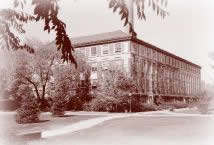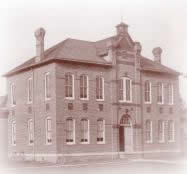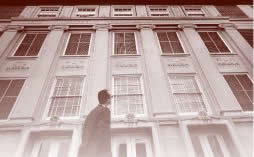Facts/History
The Department of Chemistry is today one of the largest and most distinguished instructional units at Purdue University, a role it has assumed since 1874 when Purdue first opened its doors to students. Initiating a pattern of excellence followed through the years, Dr. Harvey W. Wiley, a distinguished food chemist and father of the Pure Food and Drug Law, was appointed the first Professor of Chemistry and with five others formed the initial faculty of Purdue University.
Originally housed in Science Hall, the Department of Chemistry shared the ground floor with the Art Department. Available lab space accommodated sixteen students and the equipment purchase fund was $1400. The department expanded rapidly, moving to the old Mechanical Laboratory in the 1890s and then in 1907 to the Chemistry Building which was located on the site of the today's Liberal Arts Building. This was the first building solely occupied by the department.

By 1927, the original Chemistry building was severely overcrowded in trying to serve over 2000 students enrolled in chemistry courses. To alleviate these conditions, the first wing of the present Wetherill Building was completed in 1930, providing the teaching space required as well as some research space for the newly established graduate program. By 1930, the first two Ph.D. degrees in Chemistry were awarded and there already were 38 graduate students registered in the Department.

Under the stimulus of a rapidly growing graduate enrollment the research program of the Department flourished, gaining for the University world-wide recognition. The pioneering work in chlorination and fluorination by Professors Henry B. Hass and Earl T. McBee was the cornerstone of this program. Having achieved international renown for this work, the Department was requested during the Second World War to commit its talents and resources to the Manhattan Project.

In the late thirties, the General Chemistry laboratories were removed from the Chemistry Building to increase the space for upper level instruction and research. The General Chemistry laboratories were first moved into converted space in the old Electrical Engineering building adjacent to the Wetherill Laboratory, then shifted to the Federal War Administration (FWA) buildings in 1949 as a temporary solution until the Chemistry Building could be completed.

In 1950 permission was granted to complete the building. At this time, the talents of Professor Mellon were again called upon as he was appointed to supervise the design and construction of the new facilities. The size of the instructional program by this time precluded the possibility of incorporating the General Chemistry laboratories in the new space, so the decision was made to re-plan the addition for advanced undergraduate and graduate teaching and research. Constructed in three stages, the new addition, double the size of the existing building, was occupied in June 1955 and dedicated as the R. B. Wetherill Laboratory of Chemistry.

In 1967 the University approved construction of an addition to the Wetherill Building to be located to the east of the Wetherill Building. The new addition was opened in 1973 and provided additional space for research and permitted the General Chemistry program to finally be relocated to new quarters in the Chemistry Department. In 1979 Professor Herbert C. Brown was awarded the Nobel Prize in Chemistry for his work in hydroboration chemistry. In 1987, the east addition was dedicated as the H. C. Brown Laboratory of Chemistry.
The Department currently boasts 52 faculty, 90 support personnel, over 300 graduate students and 250 undergraduates with an annual operating budget in excess of $15 million dollars per year. The Department's General Chemistry program is presently one of the largest in the nation providing introductory instruction in chemistry to nearly 4,500 students per semester. In the areas of research and instruction the Department has world class NMR facilities, an outstanding collection of scientific literature in the M.G. Mellon Library of Chemistry, a newly equipped multi-user laser facility, the Aston Laboratory of Mass Spectrometry, the Jonathan W. Amy Facility for Chemical Instrumentation, and a state of the art X-Ray crystallography laboratory. The undergraduate program has recently expanded to include non-traditional chemistry options such as biochemistry, materials chemistry, atmospheric chemistry and environmental chemistry.